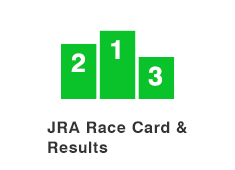Hopeful Stakes (G1) - Comments from runners' connections
NOTE: All runners are 2-year-olds, colts if not otherwise stated

Amakihi
Amakihi
Sakae Kunieda, trainer
“He was in good condition for his debut race (Oct. 27, Tokyo 2,000 meters) and he broke very nicely, so he was able to take the lead. He did spook at one point under way and lost concentration, but in the end he went neck and neck and put up a good fight. So, with that win I decided to take him here and have been giving him lots of work. On Dec. 18, Christophe Lemaire rode him and said that he’s an easy horse to ride, but doesn’t pick it up that well. We’d wanted to have him show a bit more strength in the final meters. Before his debut, he had performed better in morning work and I think he may be the type that matches whatever the other horse is doing. He still isn’t quite giving it his all in work, but he has talent. I’m hoping that if he competes with strong horses he’ll rise to match them.
|
|
|
Arion Smile
Minoru Tsuchida, trainer
“After his last start (Dec. 7), he showed no signs of fatigue whatsoever and his preparation has gone smoothly. That last race was his first after having changed trainers (previously NAR trainer Junji Tanaka), and I raced him over 1,200 meters but that was much too busy for him. Also, he seems better suited to turf than dirt. He did very well in the final stage in that race and I think he’ll do well with the longer distance. He has no problem settling or staying in tune with the rider. The competition will be much stronger this time, but if he can get a good position, I’m eager to see what kind of race he’ll gives us.” |
|

Ask Stein
Ask Stein
Nobuyuki Tashiro, assistant trainer
“In the Sapporo Nisai Stakes, he went to the front as he usually does but he wasn’t looking good in the final stage. Some of the problem may have been due to it being the last week of the meeting as well as the ground being heavy. After that, he went to the farm to recuperate and he has got ample work coming up to this race. We had the jockey (Takeshi Yokoyama) ride work last week. The colt was moving well and the rider pushed him hard to the end. He has improved with each race and I think he’ll go to the gate in good shape. He goes to the front not because he’s unable to settle, it’s because he has speed. So, I don’t think the extra distance this time will pose any problem. A nice fast track would be ideal. He’s a powerful colt weighing nearly 500kg, so he should be fine up the hill. He has already experienced shipping a long ways too. I do hope that he’ll give us a good run and that it will carry over to next year.” |
|

Claudiai
Claudiai
Shinsuke Hashiguchi, trainer
“In his last race, Kyoto Nisai Stakes, things got tight just after the break and he ended up getting a position toward the back of the field. Still, he ran strongly in the final stage (finished third). I kept him at the training center after that, and aimed him here. He worked alongside another horse over the woodchip course on Dec. 18. His responses were good and he moved well with no urging. For his last race, his weight was up 14kg from the race before that (Aug. 25), but that extra weight was growth. And from his most recent race to the present, he has grown even more and his physique has improved. He’s normally calm and laidback so I think he’ll be fine with the long trip to the track and the change in surroundings. Even from his first start, I could see that he had racing sense. If things go smoothly, I think he has a chance.” |
|

Croix du Nord
Croix du Nord
Takashi Saito, trainer
“He worked over the woodchip course under jockey Yuichi Kitamura on Dec. 25 alongside another horse and clocked 84.3 seconds over six furlongs. Last week, when the rider moved him out he switched leads, so this week we put a horse alongside him. We’re being very careful with the points of concern we cover with him in training. He’s got a strong heart and lungs and I’m hoping he’ll get a race that showcases those strengths of his.”
Yuichi Kitamura, jockey
(after trackwork Dec. 25)
“He moved really nicely. He tends to race on his right lead a lot, so this morning we had him change to the left lead in the stretch as a signal that this is the final stage and he did that very well. He has no bad points and gets high marks for his overall ability.” |
|

Del Avar
Del Avar
Mikio Matsunaga, trainer
“His weight was up 14kg for his last start, the Tokyo Sports Hai Nisai Stakes, but it was all growth. He was slow at the break and with only nine runners in the field, the pace was slow, which made the final stage very fast. He wasn’t able to bring out his best (finished fifth). In between races, he’s got gate practice every week and he’s had fast work over the woodchip course two weeks in a row. Everything is going smoothly. He’s easy to handle even though he’s by Frankel, and I’m not worried about the trip to Nakayama. Based on what I saw in his previous race, and with four turns this time, I think if things get tight that’ll actually work in his favor. I’m hoping that’s the kind of race he gets over the course.” |
|
|
Faust Rasen
Shunei Kikumoto, assistant trainer
“In his most recent start on Nov. 3 over 2,000 meters at Kyoto, the pace picked up about halfway, so the time in the final stage wasn’t that fast. It was good for this horse, because he picks up speed gradually. There’s a bit of time between races, but everything has gone smoothly. I’m hoping his trackwork will tie in with the race. It’ll be tough for him if it comes down to a fast finish, but if things get busy, which they often do at Nakayama, it’ll be good for him. This is going to be quite a test of strength and I’m eager to see how he’ll measure up.” |
|

Giovanni
Giovanni
Haruki Sugiyama, trainer
“After the Kyoto Nisai Stakes, we spent time to get him to recover from fatigue. There’s wasn’t much time between races, but he’s a horse that doesn’t need a lot of time to prepare. In his work last week, he was moving very well with the rider and though the time was relatively fast, we didn’t push him in the final stage. In his last race, he was agitated in the prerace warmup, so I’m keeping that in mind with his training. On Dec. 25, he worked up the hill course and clocked 55.9 over four furlongs with a final lap of 12.6 seconds. With that and his work last week, I have no concerns about his preparation. Last race, he didn’t run as well as I thought he would right after leaving the gate, but he did do nicely at the end. The jockey (Kohei Matsuyama) also said that he’s straighter on the bit now and has got a lot easier to ride. This time, with a lot of inexperienced horses in the field, the pace is going to be different. I’m hoping he’ll get a decent position.
|
|

Jet Magnum
Jet Magnum
Akio Adachi, trainer
“His most recent race, the Fuyo Stakes, was his first race since he’d experienced some abnormal heart rhythm (atrial fibrillation) but he traveled in a good position and won solidly. He really tried hard. His winning time wasn’t that fast, but the pace was slow. He showed us that if he gives his best he can perform well. He went to the farm after that and returned to Ritto on Nov. 7. He’s not the kind of horse that gets great times in morning work, but everything is going well. This time there are a lot of top-level horses and for him, the most important thing is that his preparation continues to go smoothly. The fact that he experienced the Nakayama 2,000 meters last race is a big plus. He showed us his ability in places and I’m looking forward to seeing how he’ll do here.” |
|
|
Jun Asahi Sora
Mizuki Takayanagi, trainer
“Two starts ago, when he finished second at Nakayama, Christophe Lemaire suggested the horse might be better suited to a more wide-open course, so I decided to aim him at Tokyo. And, even though the margin was less than a neck, he won nicely. On Dec. 18, Kazuo Yokoyama (race jockey) rode his fast work and the colt’s movement and time were both good. He’s got stronger in his hindquarters and he’s able to run without leaning on the bit. Though he may be best suited to a more spacious course, I think the distance of 2,000 meters suits him. In all his three starts, he has always run steadily, and even with the strong competition, I’m eager to see just how well he can do.” |
|

Magic Sands
Magic Sands
Naosuke Sugai, trainer
(after fast work on Dec. 25)
“He worked over the woodchip course with two other horses and clocked 81.1 seconds over six furlongs. He got a time but we didn’t push him. He had a hard workout last week (Dec. 18) over seven furlongs with a training partner, and his six-furlong time was 79.1. Not only did he get a good time, he really moved over the final furlong. It’ll be his first time at Nakayama and he’ll be facing horses he’s never met before, so it’ll be a test for him. There’s been quite a bit of time in between races (four months) but he has got ample work and he’s feeling good. I’m hoping he’ll have a good race with an eye to next year.”
Daisuke Sasaki, jockey
“He’s always been a very mature horse, but his movement and how he feels when riding is better than it was in the summer. He doesn’t have the greatest acceleration but he can race in top gear for quite a long time and that’s his strongpoint. He is a bit slow away and he’s not the most skilled at racing so I am hoping he can get more familiar with the way a race unfolds.” |
|

Masquerade Ball
Masquerade Ball
Takahisa Tezuka, trainer
“In the Ivy Stakes (Oct. 19), as well as his debut, he really wasn’t serious about running. When he lined up alongside another horse in the stretch, it was only then that he finally got serious. And for him to have won after that just shows that he has some gears. After time at the farm, he returned to the training center on Dec. 2. On Dec. 12, we gave him a long, hard ride, then on Dec. 18, jockey Keita Tosaki rode just to get a reading on him. He said, the colt is not forward enough yet and he’s still having problems around the turns. I think he has the potential to capture a G1 race, but he has a bit of a difficult temperament. It’s in his blood. For this reason, I steer away from having him come from too far off the top. There’s no problem with the distance but there is concern about whether he can the handle the four turns and the right-handed track. I’m hoping that, with an eye to the future, we can overcome those problems.” |
|

Piko Chan Black
Piko Chan Black
Yuki Uehara, trainer
“In the Ivy Stakes last out, I had thought it would be good to travel with a horse in front of him and that’s how the race panned out. He made a strong finish and I think it was a solid race. He went to the farm for a bit after that and returned to Miho on Nov. 28. Usually, when the assistant trainer is riding, he doesn’t move that much, but when the jockey’s up he switches on. In last week’s workout (Dec. 18), we had a bit of a problem with control. But the jockey (Yuga Kawada) said that as long as they were working together not even that would be a problem. By the race, we’ll try to make him easier to ride. I think the change to Nakayama and the extra distance are both pluses. If he race draws on his talent, I think he’ll be very competitive and I hope he’ll give it his best.” |
|
|
Realize Aurum
Naosuke Sugai, trainer
“He gets stronger with each race and his strongpoint is that he doesn’t get upset if he races in amid the pack. On Dec. 18, he worked over the woodchip course and he still has problems taking the bit well, so I’ll be working on that up until the race. I’m hoping he’ll improve. I think he worked very nicely last week. His overall condition is the same and I think his best distance is in the range of 1,800 to 2,000 meters.” |
|
|
Reve de l'Opera (filly)
Yoshinori Ito, assistant trainer
“She’s no longer tense like she was and her training is going well, with lots of workouts behind her. She worked over the woodchip track with a partner last week and she got into a nice rhythm over the first half and made a good effort over the last three furlongs. She does have a tendency to lose concentration when you move her out but when she’s with another horse she concentrates. She has slowly got stronger and her workouts during this preparation are her best workouts yet. I think her work is showing that she has moved up a rung. Her best, of course, is sure to come, but she is moving well now. She usually rises to the challenge so I’m looking forward to seeing how well she’ll do here.” |
|

Shonan Macbeth
Shonan Macbeth
Yasuo Takeichi, trainer
“His final workout before the Sapporo Nisai Stakes (finished eighth) two starts ago was lighter than I’d planned. He’d had excess weight then. So, for his most recent race (the Hyakunichiso Tokubetsu) I made sure to get him leaner. And, just as the jockey had predicted, when the horses lined up in front, it really brought out his competitiveness. After that, we sent him to the farm for a bit, then started his prep for here. His responses seemed a little dull so I’ve been working him with another horse, having this one chase and overtake the other. On Dec. 18, his responses were very good. I think he’s about to move up a level. He doesn’t have the sharpest turn of foot, but if he can get a good position and get into a nice rhythm, he should be able to bring out his best. After considering his talents, I decided the Hopeful Stakes was the best for him. I’m hoping he’ll give us a performance like he did last race.” |
|
|
Tjuta
Yukihiko Araki, assistant trainer
“He won nicely in his debut at Tokyo, but he may have had the advantage with the competition. Nonetheless, it was a nice for his first start. He went to the farm after that and returned to Ritto on Dec. 10. On the 18th, he worked in a trio on the woodchip flat course and he quickly stepped into the front and left the others behind. His footwork was fantastic. He’s moving better now due to his first race and you can tell by the way he moves that he has matured even in just a short time. The competition is going to take a sudden leap up and we’ll just have to see how he measures up. However, looking at his work on the 18th, I would say that even with only one start, he should be fine. He looks to have improved sufficiently and I think he’ll turn in a good race that’ll stand him well next year.” |
|
|
Yamanin Bouclier
Mikio Matsunaga, trainer
“His half-brother Yamanin Stellata has one style of racing, a late closer coming from far off the pace. This horse has a different style. He’s much more positive, more forward. The winner in the Kigiku Sho (Nov. 10) was strong, but this one went right to the front and held his ground until 200 meters out, a great show of tenacity. I don’t think it was a bad race in any way. After that race, he went to the farm and returned to Ritto on Dec. 6. Since then, everything has gone smoothly. He gave us some very good workouts on Dec. 11 and Dec. 18, moving well as he usually does. With his temperament, I don’t think the long trip to Nakayama will be a problem. He can race from any position and is in good condition, so I’m very much looking forward to the race.” |
|
Sources: Keiba Book, Gallop, Netkeiba, Radio Nikkei, Yukan Fuji
|

- Preview
- Barrier draw
- Past performances of runners

- News
- Race result
- Video
- 2024 English

- 2023 English

- 2022 English

- 2021 English

- 2020 English

- 2019 English

- 2018 English

- 2017 English

- 2016 English

- 2015 English

- 2014 English

- 2013

- 2012

2024 Winner: Croix du Nord
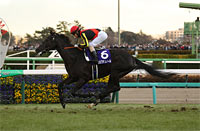
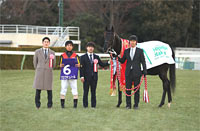
2023 Winner: Regaleira
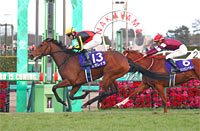
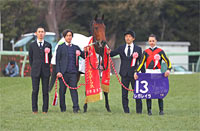
2022 Winner: Dura Erede
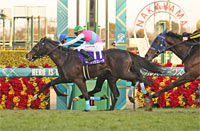
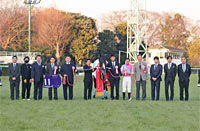
|














